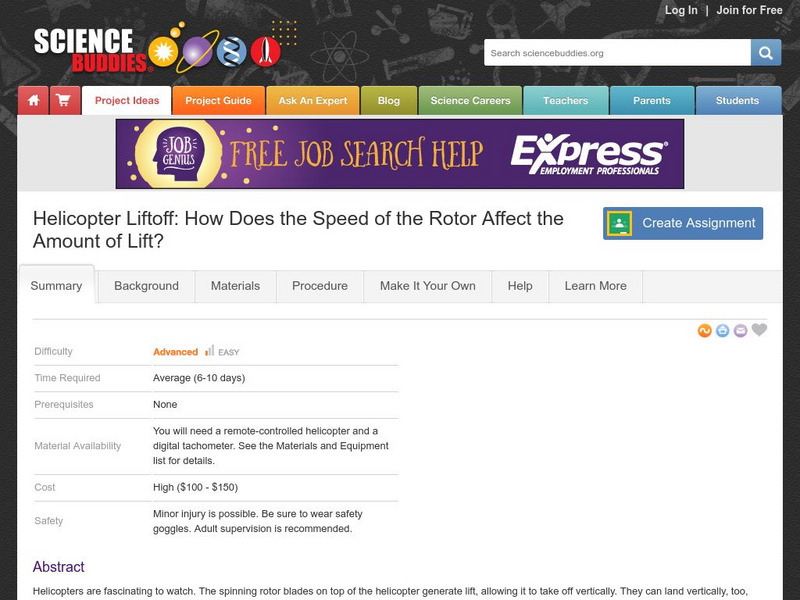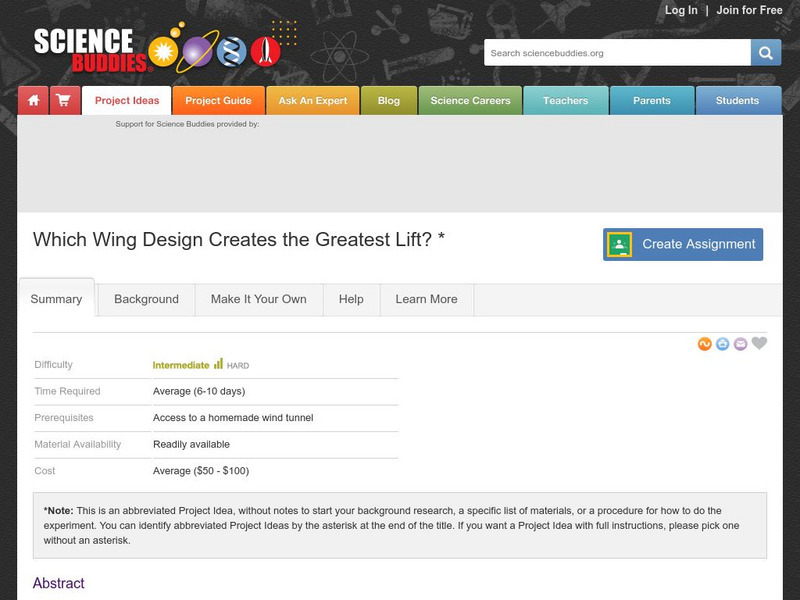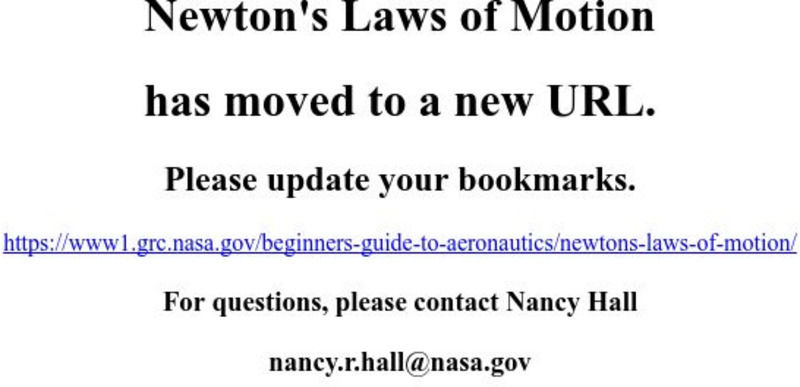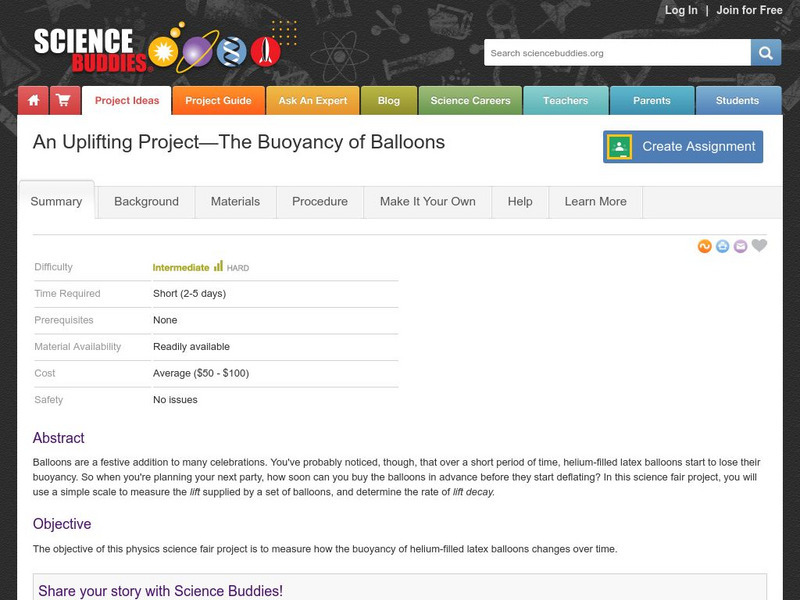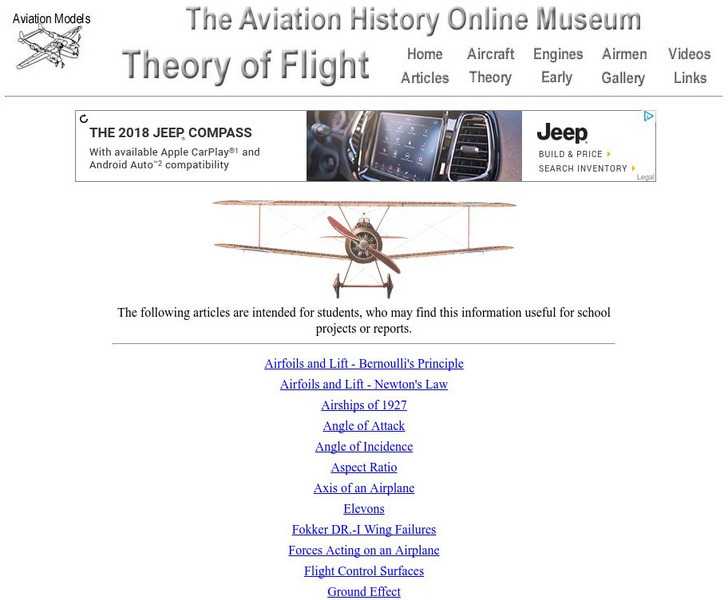Curated OER
Lift/Velocity Relationship Problem Set
Students, after reading an explanation from a NASA Web-based textbook, demonstrate their ability to use, graph (using a graphing calculator), and interpret a text equation.
Curated OER
Using Graphs to Compare
Pupils use the FoilSim computer simulation program, and demonstrate an understanding of the lift variables by explaining their graphical representations. They demonstrate an understanding of forces and motion.
PBS
Pbs Learning Media: Aerodynamics: What Causes Lift?
How does an airplane stay aloft when upside down? This media-rich essay from the NOVA Web site offers an explanation based on Newton's third law of motion.
Science Buddies
Science Buddies: Project Ideas: Helicopter Liftoff: Rotor Speed Affect on Lift
In this science fair project, measure the rate of rotation of a remote-controlled helicopter rotor, using a digital tachometer, and relate this to the lift the blade generates. The Science Buddies project ideas are set up consistently...
Science Buddies
Science Buddies: Which Wing Design Creates the Greatest Lift?
Airplane wings do not all have the same design. With this Science Buddies project you can design your own wings to see which offers the greatest lift. The Science Buddies project ideas are set up consistently beginning with an abstract,...
Science Buddies
Science Buddies: Why Do Aerobie Flying Rings Go So Much Further Than Frisbees?
Use the instructions from this Science Buddies project to develop your hypothesis on whether flying rings fly farther than flying disks. The Science Buddies project ideas are set up consistently beginning with an abstract, objective, and...
Science Buddies
Science Buddies: Winglets in Wind Tunnels
Have you noticed the little wing projections on the wings of jets? This Science Buddies project helps you understand whether these fins help stabilize airplanes. The Science Buddies project ideas are set up consistently beginning with an...
Science Buddies
Science Buddies: Why Winglets?
Make a paper airplane and experiment with adding winglets to it to test its performance. The Science Buddies project ideas are set up consistently beginning with an abstract, objective, and introduction, followed by a section on terms,...
Science Buddies
Science Buddies: Efficient Propeller Design
There's a lot to understand about the simple propeller to see how it affects lift and thrust in an airplane or helicopter. This Science Buddies project gives you lots of ideas on how to change the design of the propeller to achieve...
Smithsonian Institution
Smithsonian Learning Lab: How Things Fly: Activities for Teaching Flight
Through this series of three lessons, students will gain an understanding of the basics of flight. They will learn about the four forces of flight and practice their observation skills through a number of fun experiments. In addition,...
NASA
Nasa: Aerodynamics Index
Are you studying or teaching Aerodynamics? This page acts as an index to all the terminology related to this topic. Clicking on any title will open a page with a colored slide and a scientific explanation of the contents. Animated,...
TeachEngineering
Teach Engineering: Adaptations for Aeronautical Engineering
This activity first asks the students to study the patterns of bird flight and understand that four main forces affect the flight abilities of a bird. They will study the shape, feather structure, and resulting differences in the pattern...
TeachEngineering
Teach Engineering: Up, Up and Away! Airplanes
The airplanes unit begins with a lesson on how airplanes create lift, which involves a discussion of air pressure and how wings use Bernoulli's Principle to change air pressure. Following the lessons on lift, students explore the other...
NASA
Nasa: Model Rocket
A comprehensive tutorial that depicts the parts of a subsystem within a system. This tutorial dissects a rocket and explains how each part is integral to its actual functioning. Excellent links to otherresources dealing with aerodynamics.
Technovation
Curiosity Machine: Challenges: Engineer an Airfoil
Do you know how an airplane flys? Use this challenge to learn about flight by building a wing that can generate lift from a fan while carrying weight. Find details about the challenge, tips, and a lesson plan on this site. Also, students...
NASA
Nasa: Gas Properties Definitions
Use this site to learn about basic gas properties including motion, viscosity, and compressibility. Includes links to activities for all ages.
NASA
Glenn Research Center: Newton's Laws of Motion
NASA presents a concise explanation of Newton's three laws of motion. Click on the highlighted vocabulary to find more detailed and illustrated descriptions. Included is a link to a movie that shows how the laws of motion described the...
South Carolina Educational Television
Know It All: Lift | Nasa Online
An upward force called lift acts on the airplane and opposes the downward forces of gravity. The lift force allows the airplane to get off the ground and stay in the air. Watch the simulation to see how this works.
Children's Museum
The Children's Museum of Indianapolis: Curious Scientific Investigators: Flight Adventures
Students will make paper rockets, parachutes, and foam gliders to experience how objects move through the air. Explore topics such as thrust, weight, gravity, force, and lift through fun activities and stories and cutting-edge work done...
Exploratorium
Exploratorium: Paper Airplanes
At this site students will use origami to fold a paper airplane that fly better than the classic dart airplane.
NASA
Nasa: Flight: What Is Lift?
An explanation of the role lift plays in airplane take-off and flight.
Science Buddies
Science Buddies: An Uplifting Project: The Buoyancy of Balloons
In this science fair project, measure the "lift" of a set of balloons and track how it changes over time as the helium escapes from the balloons. The Science Buddies project ideas are set up consistently beginning with an abstract,...
Other
Aviation Internet Group: Aviation Theory
Collection of articles ranging from basic to advanced on aerodynamics theory.
NASA
Nasa: What Is Lift?
A description of how lift is a mechanical force that requires a fluid moving through a solid object and a change in velocity.





